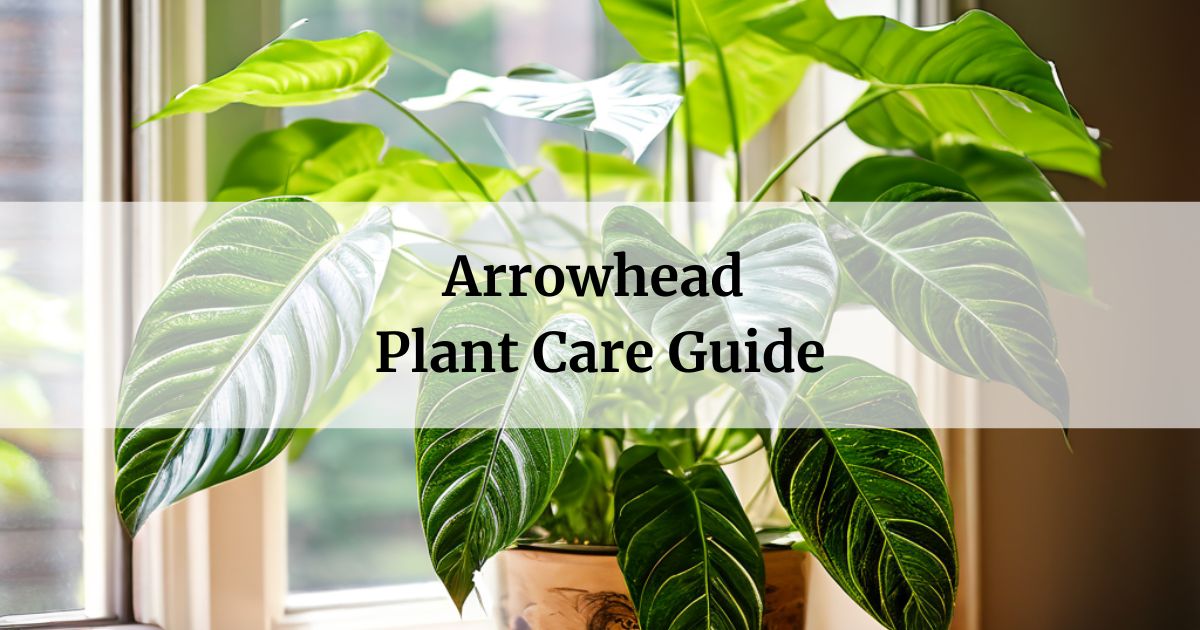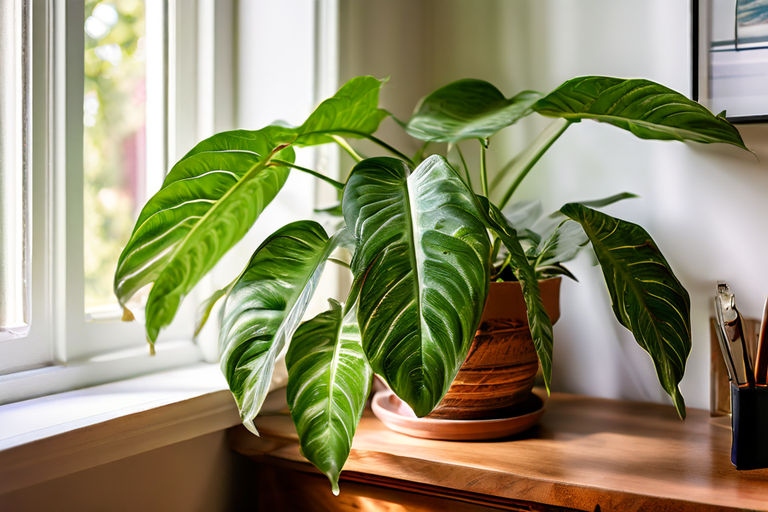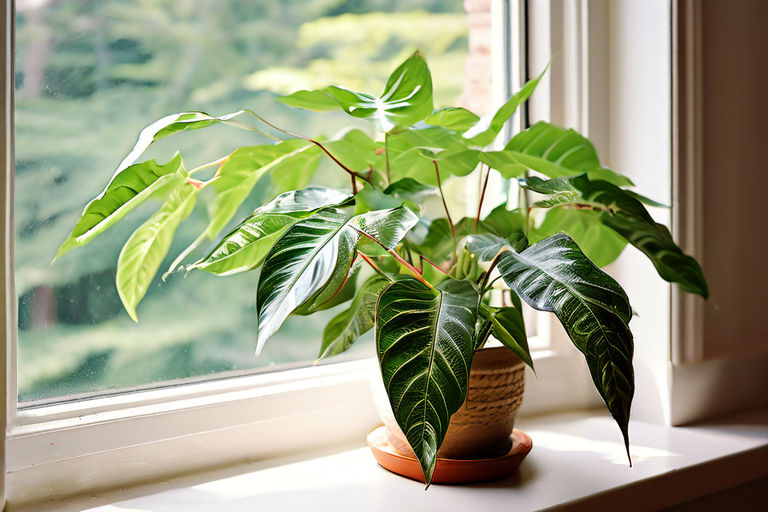
The Arrowhead plant (Syngonium podophyllum) is a unique houseplant with arrowhead shaped green leaves. A super hardy houseplant, this epiphytic vine from tropical America is very easy to care for and thrives in low light. Expect beautiful foliage that makes an eye-catching accent to any room.
- Pros
- Pet safe
- Tolerates low light
- Air purifying
- Fun arrowhead leaves
- Easy care
- Cons
- May get leggy without pruning
- Can be invasive outdoors
In this article
- 1 Appearance of the Arrowhead plant
- 2 Light Requirements for the Arrowhead plant
- 3 Watering the Arrowhead plant
- 4 Fertilizing the Arrowhead plant
- 5 Potting the Arrowhead plant
- 6 Propagation of Arrowhead plant
- 7 Growth and Development of the Arrowhead plant
- 8 Managing Pests and Diseases for the Arrowhead plant
- 9 Complimentary Plants with your Arrowhead plant
Appearance of the Arrowhead plant

The distinguishing characteristic of the Arrowhead plant are its unique leaves. Arranging spirally up the stem, the leaves are shades of green ranging from dark to light and made up of 3 to 7 arrow or heart shaped leaves. Leaf sizes can reach up to 6 inches long. Stems are green and can grow several feet long if allowed. New growth emerges pinkish red before maturing to green.
Great for People who:
Want a low maintenance plant to liven up their home without fuss. It thrives on neglect.
Great for these Spaces:
Trailing varieties of Arrowhead plant work well hanging from shelves or allowed to cascade over the edge of a table. Its small size also makes it suited to desktops.
YOU MAY ALSO LIKE: My Top 5 Beautiful Houseplants
Caring for Arrowhead plant
Very easy. Water when top 1-2 inches of soil are dry. In warmer months water every 7-10 days. During cooler times, every 2-3 weeks. They are quite drought and low light tolerant once established.
Toxicity Level of Arrowhead plant
Perfectly safe for homes with pets or kids. All parts of the Arrowhead plant are non-toxic.
Light Requirements for the Arrowhead plant

Though Arrowhead plants go dormant without direct sun, they are quite tolerant of low light conditions. They thrive indoors under medium to low light levels ranging between 500-1000 hours indirect sun annually. East or north facing windows work great. With insufficient sun, leaves become lighter green and stems grow leggy with few leaves.
| Light Conditions | Effect on Arrowhead plant |
|---|---|
| Bright Indirect Light | Compact growth and large leaves |
| Low Light | Will survive but grow leggy |
| Direct Sunlight | May scorch in hot conditions |
Watering the Arrowhead plant
Allow soil to dry out between waterings for the Arrowhead plant. I water mine when the top 1-2 inches are dry, every 7-14 days. They are very forgiving if you forget occasionally. Avoid overwatering as wet soils cause root rot. Use a well-draining soil to prevent soggy conditions.
- Check soil moisture weekly by finger test
- Water when top 1-2 inches are dry
- Pour off any excess water in saucer
- Allow soil to dry slightly between waterings
Fertilizing the Arrowhead plant

Rootblast Garden Fertilizer
- Simple to use – Just one scoop – Once per season
- Use it on all your plants –flowers (annuals & perennials), vegetable, bushes, and trees
- And its safe – all natural earth elements with no hormones or harsh chemicals
Arrowhead plants thrive with occasional fertilizer during their active growing season from spring to fall. I recommend a dilute houseplant fertilizer every 2-3 months. Follow label instructions and flush with fresh water to avoid salt buildup. They do not require much nutrients since they are very low maintenance.
- Spring (April-May): quarter strength
- Summer (June-Aug): quarter strength monthly
- Fall (Sept-Oct): quarter strength every 6 weeks
- Winter: No fertilizer
Potting the Arrowhead plant

Repot an Arrowhead plant every 1-2 years or when it becomes rootbound. In spring or early summer, use a container with drainage that is 1-2 inches larger. Gently remove from old pot being careful of delicate roots. Use a well draining, loose soil. Water thoroughly after to settle roots in. Trim any dead or leggy stems.
- Carefully remove from existing pot
- Prepare new pot and soil
- Place rootball in center and backfill with soil
- Firm gently and water
- Trim any dead or scraggly stems
Propagation of Arrowhead plant
Arrowhead plants are easily propagated through stem cuttings. In spring or summer, take 4-6 inch cuttings leaving a few sets of leaves. Remove the bottom leaves and place cut end in water. Roots will form within 2-4 weeks. Once established, plant in soil. It’s a great cost effective method to grow more.
- Take 4-6 inch stem cuttings with nodes
- Remove bottom leaves, place cut end in water
- Change water weekly, watch for roots
- Plant in soil once roots develop
- Keep soil moist while new plant establishes
Growth and Development of the Arrowhead plant
Vining Arrowhead plants can reach several feet long if allowed. Keep pruning stems to desired height and shape. They prefer warm to temperate conditions, around 65-80° F. Medium to high humidity levels 50-70% are ideal to prevent brown spotting and crisp leaves. The best time to introduce is during spring and summer for established root systems before cool fall/winter months.
With infrequent water and no direct sun, Arrowhead plants develop very slowly. At times you may not notice growth at all. Have patience with their leisurely nature and focus on enjoying their low maintenance nature. Expect a long lived, trouble free plant that asks little from you.
Managing Pests and Diseases for the Arrowhead plant
Rarely affected besides occasional presence of spider mites in dry conditions. I wipe leaves with a cloth dampened with neem oil or insecticidal soap if seen. Brown tips indicate room is too hot/ dry – move to slightly cooler area. Rotted roots from overwatering causes yellow leaves. Improvement brings new growth.
Complimentary Plants with your Arrowhead plant
Frequently asked questions
Mine isn’t growing, any tips?
Move it to a slightly sunnier spot and increase humidity. Growth is very slow without optimal care.
Can I grow it outdoors in summer?
Yes, but provide protection from direct sun to prevent leaf burn. Bring in before nighttime temps drop below 50°F.
How do I make it bushier?
Prune leggy stems back to encourage dense growth from nodes. Increase humidity too.
Do the leaves change color?
Sometimes new growth emerges reddish before maturing green. Leaves also develop cream or white variegation in some cultivars.
What’s the best potting mix?
A peat-based potting soil amended with perlite for drainage. Avoid soggy wet soil conditions.
With its low water, low light needs and virtually carefree nature, the Arrowhead plant is tough to kill. Its beautifully unusual foliage brings charm to any space. It makes a wonderful addition if you want beautiful greenery without maintenance being a chore. Enjoy your arrow leaf plant!
Happy gardening!







